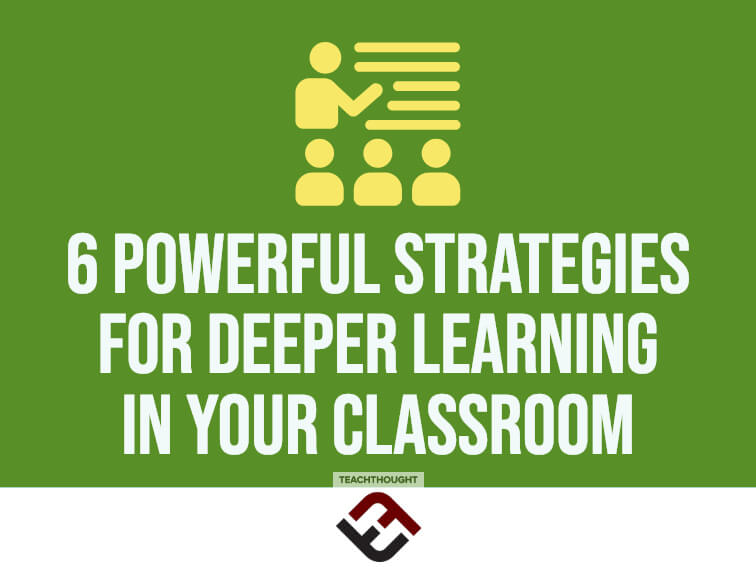
What Powerful Strategies Can Help You Achieve Deeper Learning In Your Classroom?
contributed by Dr. Monica R. Martinez
In the U.S., millions of middle and high school students attend schools that don’t match the reality of their lives. By their teenage years, young people should be solving complex problems, thinking critically about tough concepts, and communicating their ideas effectively. Yet, our schools are organized to be lecture-based, encouraging students to simply memorize facts and follow rules.
In my book, “Deeper Learning: How Eight Innovative Public Schools are Transforming Education in the Twenty-First Century,” I take you inside a growing movement that represents what should be the new normal. Deeper Learning is a set of student outcomes that includes mastery of essential academic content; thinking critically and solving complex problems; working collaboratively and communicating effectively; having an academic mindset, and being empowered through self-directed learning.
This more robust and responsive educational experience offers a new framework for educators and schools to rise to the challenge of preparing students for college, careers, and the world today. The eight schools profiled in my book are embracing Deeper Learning principles with six core strategies.
6 Powerful Strategies For Deeper Learning In Your Classroom
1. Connect: Create a Community of Learners
The development of strong school communities is essential for students to evolve from playing a passive role in their education to being active, self-directed learners. To create a more cohesive, genuinely collaborative school environment, blend support and trust with high expectations and a collective responsibility for learning.
Here are some ways to build strong learning communities: inspire students to care about each other’s success; re-orient students to the value of learning and self-direction through various schoolwide activities, messaging, and rituals; involve older students as mentors, models, and guides; establish norms for constructive learning feedback and reflection, and design the building to reflect an environment that promotes openness and collaboration.
2. Empower: Activate Students to Lead Their Own Learning
Active and meaningful educational experiences are critical in helping students reach Deeper Learning goals. Whether it’s designing an app, organizing a mock election representative of the electoral process, or generating electricity by building wind turbines, schools that embrace Deeper Learning objectives emphasize inquiry-based learning and take care to get students working actively and productively in groups to create products or to solve problems together.
Teachers must constantly shift roles, from curriculum design to advising to coaching to networking, and so on.
3. Contextualize: Use Human Themes
Evidence supports the fact that learning becomes more meaningful–with deeper understanding of material–when material is personally relevant and subjects are integrated. Subjects are not taught in isolation and instead learning is connected to larger themes, concepts and across multiple subjects and apply their learning to real-world issues and problems.
As Susan McCray, a teacher from Casco Bay High School states, “Everything is related. Everything matters, and we are all working all the time to help them [students] see the connections.” This can include a nine-month unit that combines humanities, chemistry or courses that can be linked quarterly by a ‘theme’ such as democracy or sustainability.
See also Examples Of Essential Questions
4. Reach: Network Beyond School Walls
Reaching beyond classroom walls helps provide students with a more holistic learning experience. As consummate networkers, teachers scout opportunities for their students and tap local resources like museums and corporations that match the schools learning philosophy as well as students’ interests and projects, generate extended networks of support and learning for students, and help them explore potential career paths through internships or mentorships.
5. Inspire: Personalize The Learning
Finding the spark—a subject, idea, or project that makes a student light up—is the key to personalized learning experiences for individual students. In order to tailor learning to meet individual students’ educational needs and aspirations, teachers should seek out and develop a balanced knowledge of each student’s unique tendencies, circumstances and interests through both formal processes(advisories) and informal processes (including casual conversations, insight from parents or other teachers) means.
6. Wire: Make Technology the Servant, Not the Master
Deeper Learning incorporates technology purposefully to enhance, rather than automate learning. This happens in several ways, among them using programs and applications that build students’ research and critical thinking skills, offer digital methods to design projects, collaborate and communicate within and outside of the school, and broaden students’ options for presenting work creatively and connecting with multiple experts. In all of these cases, technology is used as a tool to drive student learning.
Deeper Learning truly has the ability to redefine what teaching and learning looks like in the 21st-century. It’s time for us to invest in Deeper Learning and designate it as the new normal.
Dr. Monica R. Martinez is a leading education strategist, author, presenter, and Appointee by President Obama to the President’s Advisory Commission on Educational Excellence for Hispanics. She, along with education sociologist Dennis McGrath, is the author of Deeper Learning: How Eight Innovative Public Schools Are Transforming Education in the Twenty-First Century; image attribution wikicommonsmedia; 6 Powerful Strategies For Deeper Learning In Your Classroom
